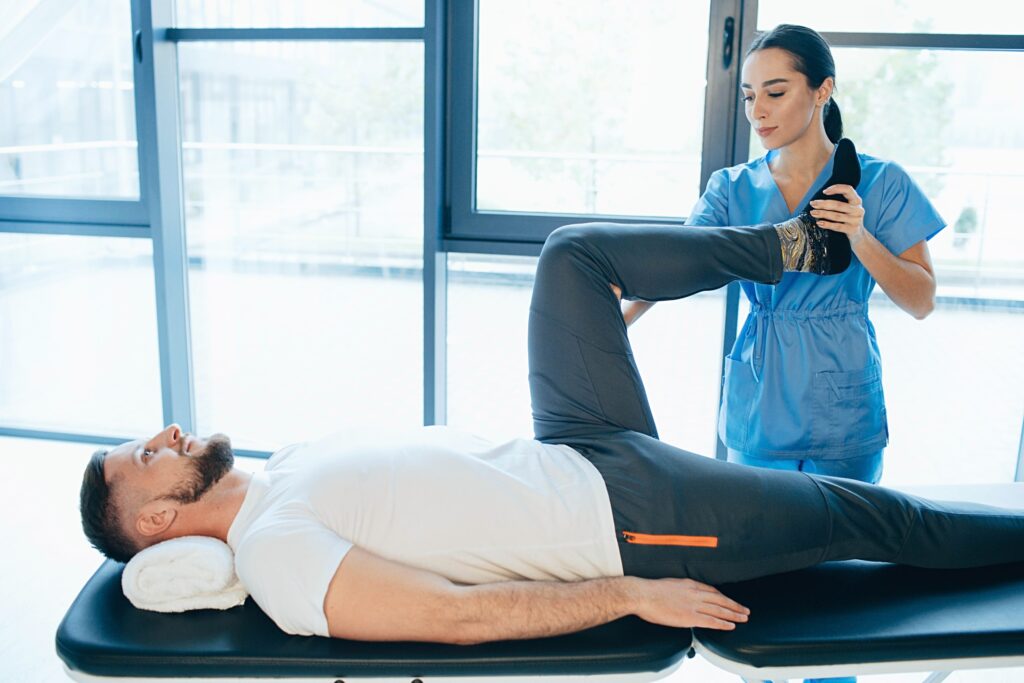The human body is an intricate and remarkable machine, capable of extraordinary feats when working well. Yet even the most well-oiled systems can occasionally encounter hiccups, as evidenced by the common occurrence of hip flexor strains. While often linked to sports, these frustrating injuries can affect anyone, making it hard to move and causing pain.

Understanding the Hip Flexors
Hip flexors are muscles at the front of your thigh that help you lift your knee to your chest and bend at the waist. This group includes the iliopsoas, sartorius, and rectus femoris muscles, which work together to allow a wide range of movements.
When these muscles or their tendons get strained or overused, you get a hip flexor strain – a painful problem that can limit your ability to move freely and be active. Strains can be mild tears in the muscle fibers or complete ruptures, each needing its own approach to treatment and recovery.
Causes of Hip Flexor Strains
Hip flexor strains can occur for various reasons, but the most common are overuse, sudden injury, and not warming up or stretching properly. Athletes who do sports with lots of high-knee movements, like running, soccer, hockey, and martial arts, are more likely to get these injuries. Also, people with muscle imbalances, poor fitness, or past thigh or hip injuries may be more at risk of getting a hip flexor strain.
Symptoms of Hip Flexor Strains
The primary symptom of a hip flexor strain is a sudden, sharp pain at the front of the hip, often accompanied by a popping or tearing sensation. Other common signs include:
- Weakness or instability when attempting to lift the leg or kick
- Muscle spasms in the thigh
- Tenderness and swelling in the affected area
- Bruising that typically appears within 48 hours of the injury
Hip Flexor Strain Grades
Hip flexor strains are classified into three distinct grades, each representing a different level of severity:
- Grade 1 Strain: A mild injury with slight tearing of muscle fibers. You’ll have a bit less strength and function, but not much.
- Grade 2 Strain: A moderate injury with more tearing. You’ll notice you’re weaker and can’t move as well.
- Grade 3 Strain: A severe injury where the muscle completely tears. This doesn’t happen often, but when it does, it can limit what you can do and might need surgery.
Knowing how bad the strain is helps guide recovery and ensures you get the proper treatment.

Treatment Options
When a hip flexor strain first occurs, doctors often suggest using the RICE method. This tried-and-true approach helps reduce swelling, ease pain, and start the healing process.
- Rest: Refrain from doing things that hurt the injury. This gives the damaged muscles a chance to start healing. In bad cases, you might need crutches or other help to walk.
- Ice: Apply cold packs or apply ice massage to the hurt area. This helps with swelling and pain. Do this for 10-15 minutes several times a day, especially in the first two days after the injury.
- Compression: Wrap the hurt hip and thigh with a bandage or wear tight shorts. This helps keep the area stable and reduces blood flow to the injured parts, which aids healing.
- Elevation: Keep your hurt leg higher than your heart. This helps reduce swelling and drain extra fluid.
In addition to these steps, you might take over-the-counter pain meds like ibuprofen or naproxen to help with pain and swelling.
Rehabilitation and Strengthening
As the worst of the injury passes, you’ll start focusing on returning to normal. This involves a complete plan to restore strength, flexibility, and range of motion. Physical therapy can provide a customized plan tailored to your needs and recovery goals.
Gentle stretching is key to getting your hip flexor muscles moving and stretching normally again. You’ll start easy and do more as you heal. Strengthening exercises, including hip flexion, leg raises, and core work, help rebuild muscle strength and prevent future injuries.
Your plan might also include:
- Gradual return to your usual activities
- Specific exercises for your sport or daily tasks
- Tips to prevent getting hurt again
Lifestyle Adjustments to Prevent Hip Flexor Strains
While hip flexor strains can be annoying and disruptive, there are several steps you can take to lower your risk of getting hurt:
- Warm Up and Stretch Properly: Warm up and do dynamic stretches for your hip flexors before activity. This prepares your muscles and reduces strain risk.
- Build Strength and Flexibility: Keep your core and lower body strong, and make sure your hip flexors are flexible. This helps protect against strains.
- Increase Activity Gradually: Slowly ramp up how hard and long you exercise. This lets your body adjust and avoid overuse injuries.
- Use Correct Form: Learn the right way to do activities that use your hip flexors, like running, kicking, or high knees. Good form reduces stress on these muscles.
- Mix Up Your Workouts: Do different types of exercise to avoid overusing specific muscles. This spreads out the work and lowers strain risk.

Contact Dr. Peter Howard for Treatment
Hip flexor strains are common but manageable with rest, targeted treatment, and a full rehab program. Most people can recover and return to their favorite activities with patience and expert guidance. If you’re dealing with a hip flexor strain, contact Dr. Peter Howard, M.D., today for personalized care and a tailored treatment plan to help you heal stronger and faster.
